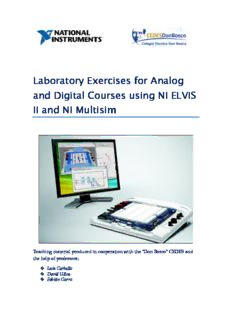
Laboratory Exercices for Analog and Digital Circuits Using NI ELVIS II & NI Multisim PDF
Preview Laboratory Exercices for Analog and Digital Circuits Using NI ELVIS II & NI Multisim
Laboratory Exercises for Analog and Digital Courses using NI ELVIS II and NI Multisim Teaching material produced in cooperation with the "Don Bosco" CEDES and the help of professors: Luis Carballo David Ulloa Fabián Garro Table of Contents DC Electric Circuits 1. Ohm's Law 2. Kirchhoff's Voltage Law 3. Kirchhoff's Current Law 4. Thevenin and Norton Equivalent Circuits 5. Voltage Divider and Resistance Bridge 6. Series and Parallel Capacitors AC Electric Circuits 7. RC Circuits 8. RLC Circuits 9. Transformers and Turn Relationship Analog Electronics 10. Diodes 11. Bipolar Transistors 12. Transistors Used as Interrupters 13. Transistors Used as Amplifiers Digital Electronics 14. Logic Gates 15. Karnaugh Maps 16. Flip Flops 17. Multivibrator Circuits (555) 18. Analog-to-Digital Converter (ADC) 19. Digital-to-Analog Converter (DAC) DC Electric Circuits Exercise 1 Ohm's Law Introduction One of the first people to research electricity was Gorge Simon Ohm, a German physicist who taught mathematics. His experiments showed that a current is directly proportional to the applied voltage and inversely proportional to the circuit's resistance. Based on his studies, Ohm proposed an equation linking voltage, current and resistance, known as Ohm's law, where: "I" is the current's intensity in Amperes (A) "V"is the voltage in Volts (V) "R" is the resistance in Ohms (Ω) It can be said that if the voltage of a resistance increases or decreases, the current going through the resistance will increase or decrease proportionally. Using algebra, Ohm's law can be expressed in two additional ways: Another fundamental law of electricity is Watt's law, named in honor of the Scottish inventor James Watt, which defines power in terms of voltage and current, as follows: Where "P" is power in Watts (W) "I" is the current's intensity in Amperes (A) "V" is the voltage in Volts (V). Objective Verify the three ways in which Ohm's law can be used to calculate voltage, current and resistance. Parts List - 1 330 Ω resistor - 1 1kΩ resistor - 1 3.3 kΩ resistor 1. Using the following circuit, calculate the current flowing through the resistor for an R1 value equal to 330 Ω, 1 kΩ, 3.3 kΩ, for different voltage supply (Vs) values, as shown in Table 1-1. Write the resulting values in Table 1-1 Table 1-1. Current calculated for different resistance values Vs R= 330 Ω R= 1 kΩ R= 3.3 kΩ (V) Measured I Measured I Measured I Calculated I (mA) (mA) Calculated I (mA) (mA) Calculated I (mA) (mA) 1 2 3 4 5 6 7 8 9 10 2. Use the NI ELVIS II to set up the previous circuit as illustrated above. 3. Turn the NI ELVIS II on using the switch located at the rear of its base. 4. If the NI ELVIS II is properly plugged in and connected both to the power supply and a PC, the PC should recognize the device and display a dialog box asking which action you would like to perform. Select NI ELVISmx Instrument Launcher. 5. If the circuit is properly set up, turn on the prototype board's switch: **For your own safety, turn this switch off every time you make wiring changes. After turning the switch on, the LEDs indicating the + 15, -15 and +5 V fixed voltage supply will also come on. ** Should any of these sources have a short circuit, you will hear a "click" and the LED corresponding to the shorted supply circuit will turn off. Turn off the prototype board switch, fix the short circuit and turn the prototype board back on. 6. Using the NI ELVISmx Instrument Launcher, activate the following measuring instruments: - DMM (Digital multimeter) - VPS (Variable Power Supply 0-12 V DC) DMM (Multimeter) VPS (Variable Power Supply) 7. Set the positive variable power supply at approximately 1 V. ** The voltage of the variable power supply can be controlled from the PC using the knob or the numeric pad, or manually using the knobs located on the baseof the NI ELVIS II. 8. Now we will measure the voltage. Since voltage is measured in parallel, the ends of the multimeter will be placed on the resistor's terminals. The ends of the multimeter are connected to the banana jacks located on one side of the ELVIS. The red end (positive) will be connected to the terminal labeled V, and the black end (negative) will be connected to the terminal labeled COM. 9. Using the multimeter, check that the measured voltage is equal to the voltage value provided by the variable supply. To carry out this measurement, you must select the direct current voltage and press the "Run" button. Now we will measure the current. Since currents are measured in series, it will be necessary to open the circuit and make the current flow through the multimeter. The circuit can be opened between one of the resistor's terminals and ground. The red end must be connected to the resistor's terminal and the black end to ground. The red end must be unplugged from the banana jack labeled V in ELVIS and plugged in to the terminal labeled A. 10. Using the multimeter, measure the current and write the data in Table 1-1. The multimeter must be set to measure direct current. Do not forget to press the Run button. 11. Repeat the step above for all voltage values (from 1 V to 10 V), changing the value at the variable power supply, and write down the current values in Table 1-1.
Description: